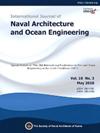基于虚拟约束试验的大舵风助船舶操纵模型辨识
IF 3.9
3区 工程技术
Q2 ENGINEERING, MARINE
International Journal of Naval Architecture and Ocean Engineering
Pub Date : 2025-01-01
DOI:10.1016/j.ijnaoe.2025.100664
引用次数: 0
摘要
采用风助推进系统(WAPS)的船舶通常配备大型方向舵以补偿风助推进系统引起的漂移力。WAPS也显著影响用于描述船舶机动特性的数学模型的有效性。本文提出了一种模块化的机动模型,对原有的MMG模型进行了改进,目的是对具有WAPS的舰船进行精确的机动仿真。提出了一种虚拟自保试验(VCT)方法,用于模拟机动模式下自由运行模型试验(FRMT)中作用在WAPS船舶上的力,识别模块化模型中的所有参数。通过对VCT数据的线性回归,确定了模型内的水动力阻尼系数。然后利用全非线性势流(FNPF)面板法从纯偏航和纯摇摆模拟中确定附加质量。以wPCC和Optiwise两艘WAPS船舶为例,通过模型试验的逆动力学验证了所提方法的有效性。wPCC配备了半经验舵,该舵先前已被证明可以很好地用于这种双舵船。本文提出了一种新的二次型MMG舵模型,对优选单舵进行了建模。结果表明,逆动力学分析和状态vct是一种有效的模型分析方法,当使用正确的vct时,可以有效地识别出机动模型。然而,逆动力学分析也揭示了由于对波浪产生和横摇运动的错误假设,wPCC VCT数据可能存在误差。在Optiwise测试用例中,这些假设应该更有效,与FRMT逆动力学表现出更好的一致性。本文章由计算机程序翻译,如有差异,请以英文原文为准。
Identification of maneuvering models for wind-assisted ships with large rudders using virtual captive tests
Ships with wind-assisted propulsion systems (WAPS) are often equipped with large rudders to compensate for WAPS-induced drifting forces. The WAPS also significantly affects the effectiveness of mathematical models used to describe the ship’s maneuvering characteristics. In this study, a modular maneuvering model is proposed to enhance the original MMG model, with the aim of producing accurate maneuvering simulations for ships with WAPS. Methods of virtual captive tests (VCT) are proposed to recreate the forces acting on WAPS ships during free-running model tests (FRMT) in motor mode, identifying all the parameters in the modular model. The hydrodynamic damping coefficients within the model are determined through linear regression of the VCT data. The added masses are then determined from pure yaw and pure sway simulations using a fully nonlinear potential flow (FNPF) panel method. Two ships designed for WAPS, wPCC and Optiwise, are used to validate the proposed method based on the inverse dynamics of their experimental model tests. The wPCC is equipped with a semi-empirical rudder that has previously shown to work well for this twin-rudder ship. The Optiwise single rudder is modeled with a new quadratic version of the MMG rudder model, proposed in this paper. Inverse dynamics analysis, together with state VCTs, is concluded to be an efficient way to analyze the models, and the maneuvering model can be efficiently identified when the correct VCTs are used in the proposed method. However, the inverse dynamics analysis also revealed potential errors in the wPCC VCT data due to false assumptions about wave generation and roll motion. The Optiwise test case, where these assumptions should be more valid, showed much better agreement with the FRMT inverse dynamics.
求助全文
通过发布文献求助,成功后即可免费获取论文全文。
去求助
来源期刊

International Journal of Naval Architecture and Ocean Engineering
ENGINEERING, MARINE-
CiteScore
4.90
自引率
4.50%
发文量
62
审稿时长
12 months
期刊介绍:
International Journal of Naval Architecture and Ocean Engineering provides a forum for engineers and scientists from a wide range of disciplines to present and discuss various phenomena in the utilization and preservation of ocean environment. Without being limited by the traditional categorization, it is encouraged to present advanced technology development and scientific research, as long as they are aimed for more and better human engagement with ocean environment. Topics include, but not limited to: marine hydrodynamics; structural mechanics; marine propulsion system; design methodology & practice; production technology; system dynamics & control; marine equipment technology; materials science; underwater acoustics; ocean remote sensing; and information technology related to ship and marine systems; ocean energy systems; marine environmental engineering; maritime safety engineering; polar & arctic engineering; coastal & port engineering; subsea engineering; and specialized watercraft engineering.
 求助内容:
求助内容: 应助结果提醒方式:
应助结果提醒方式:


